
At last, the doors along the south wall open and we’re ushered out of the lobby and into the ride’s loading area. It’s stylized to look like a 1930s studio soundstage set with a cyclorama vignette of the Hollywood Hills around, alight by the neon marquee of a theater, ahead. As the stirring sounds of “Hooray for Hollywood” and other 1930s classics surround, you can feel the excitement of Hollywood in the air! The magic! The music! The magnificence!
Today, our vehicle will be an unusual sort of tram with two distinct cars. It’s fitting that this large ride vehicle echoes the look and feel of a theater. (And that, by the way, is precisely what it is… while smaller and narrower than its use there, these are of the same “moving theater” ride system used by Epcot’s Lost Legend: Universe of Energy.)
As we slide into the rows, an exuberant tour guide through our magical world of the movies joins in the first car. And with the call of “Action!” we are rolling!
Lights, camera, action!
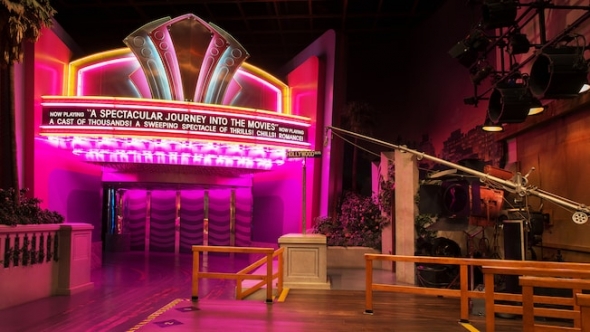

Hooray for Hollywood
That screwy, ballyhooey Hollywood
Where any office boy or young mechanic
Can be a panic, with just a goodlooking pan
Where any barmaid can be a star maid
If she dances with or without a fan!
And just like that, as the lights of the Hollywood Hills shimmer around us, the theater lumbers to life, slowly advancing forward through the soundstage and toward the shimmering neon marquee ahead. As we pass beneath the glowing incandescent bulbs of the theater entrance, our tour guide catches us up… we won’t be seeing these movies in the ordinary way; it’ll be as if we’re in the movies!
And around the corner, we encounter our first! Busby Berkeley’s groundbreaking 1933 James Cagney musical classic, Footlight Parade. Beneath an ornate carved proscinium, a pyramid of chorus girls stands and sings! (When the ride first opened, this elaborate mechanism made each layer of the “cake” pyramid rotate in opposite directions, creating a dynamic and exciting scene! When the mechanism broke, a scrim with projected art deco decals helped obscure how very static the scene otherwise would be.)
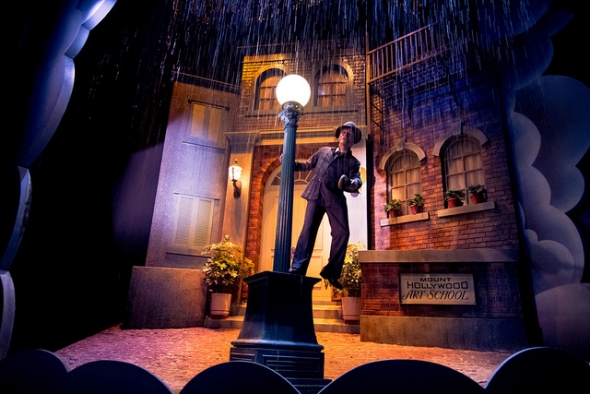
Around the corner and more than a decade forward, we pass by an animatronic of Gene Kelly who is, indeed, Singin’ in the Rain, famously perched on the base of a streetlamp outside the Mount Hollywood Art School.
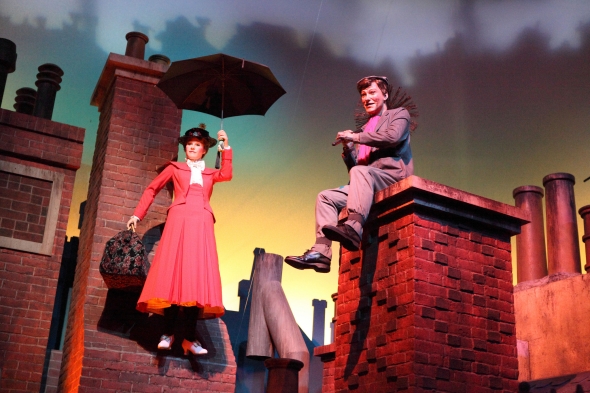
Passing through stylized art deco clouds, we arrive on the rooftops of London for an encounter with a delightful, floating animatronic of Julie Andrews’ Mary Poppins with Dick Van Dyke’s Bert as they sing “Chim Chim Cher-ee” from the Academy Award winning 1964 film.
Theaterjacked
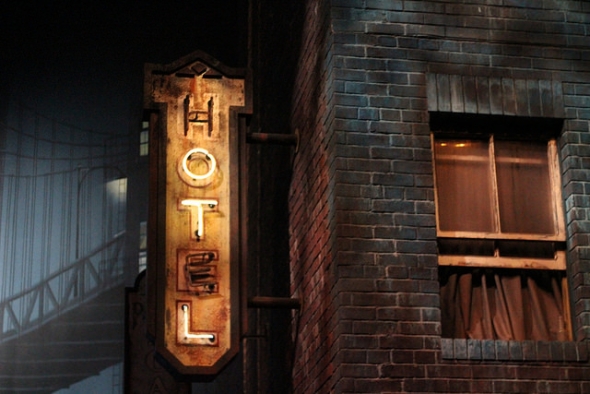
Leaving the merry olde streets of London behind, a very different cityscape comes into view. It’s a dark and stormy night in a 1930s Chicago, and we appear to have stumbled upon a seedy area of town… “Hold onto those wallets folks,” our guide advises, “this doesn’t look like a very good neighborhood… in fact, it looks like the underworld seen insuch classic gangster films such as The Public Enemy.”
And indeed, we glide past an animatronic of James Cagney as Tom Powers.
Now, usually, we’d want to high tail it out of this crime-infested neighborhood. But a red light over a tunnel stops us in our tracks. “I don’t want to break the law, folks… even if it is just a movie.”
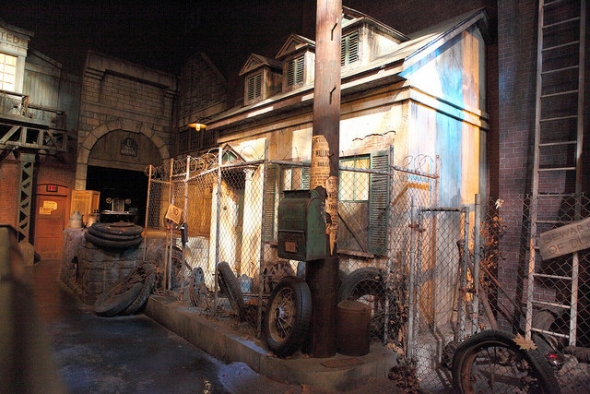
But now, to the left, we notice a few suspicious figures hiding behind shipping crates. “Is it them?” one weasel-voiced gangster whispers. “Nah, just a bunch of rubber-necking tourists…” That’s Beans and Squid… and they’re nothing but henchman to the real baddy. A gangster steps out from behind the shadows on a nearby porch. “Hey, you…”
Our guide looks around and spots him. “You talkin’ to me?” she offers.

The self-identified “Mugsy” asks our tour guide to hop off the tram and join him on the set. She refuses, since she’s not supposed to leave the vehicle. But Mugsy, brandishing a gun, changes her mind. Mugsy ambles off the porch, stepping down toward the ride vehicle. This much is clear… this is not an animatronic.
Interrupting the scuffle, a car screams into the scene to the tram’s right. “Here they come, boss! Get out your grinders!” Squid and Beans rise up, brandishing tommy guns. An all-out shootout erupts around us as the rival gangsters send bullets whizzing over our heads, ricocheting across the streetscape.
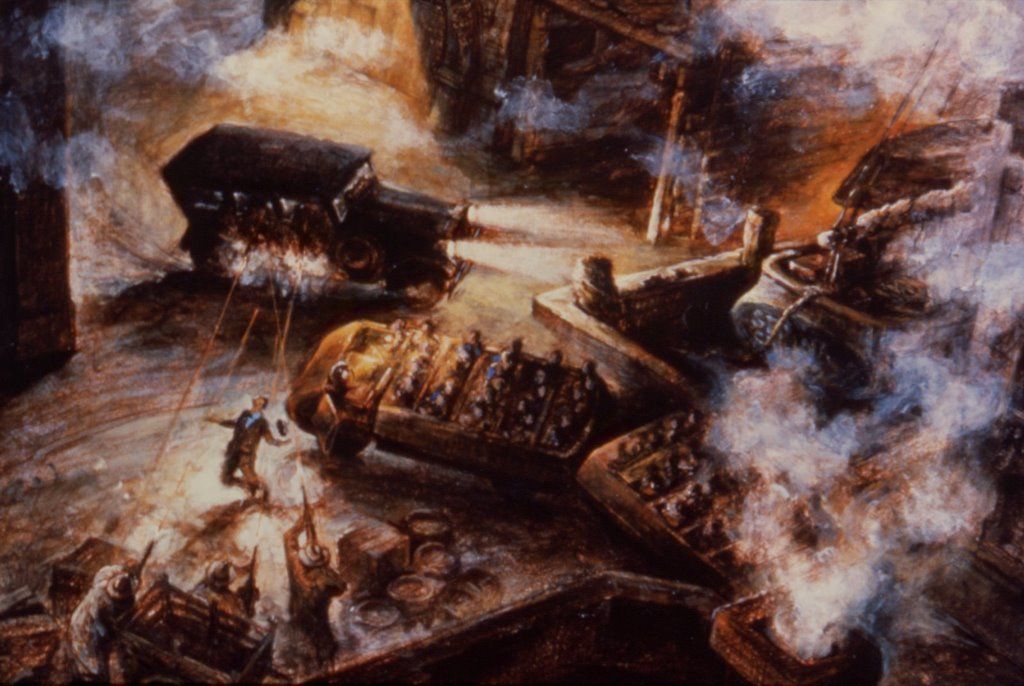
As our guide ducks for cover, Mugsy races aboard the tram, taking her place. “Everybody just sit tight,” he says, raising the pistol high. “We’ve got a red light and I never break the law.” He points and shoots, shattering the red light that had stopped us just moments ago. “No more red light,” he muses. Then, he takes control of the wheel and steers us on ahead through the tunnel.
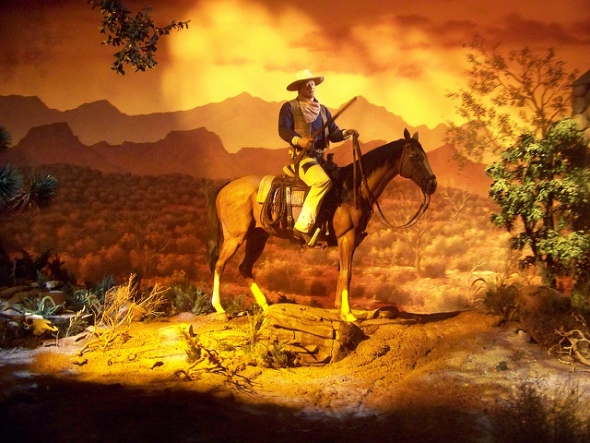
Ahead, a very different sight appears: a western mining town as a living tribute to the Western genre. This visit wouldn’t be complete with the Man With No Name (the recurring Spaghetti Western character portrayed by Clint Eastwood) outside a saloon and Ethan Edwards (John Wayne) on horseback. Mugsy – quite unfamiliar with this sudden change of scene – drives us through the town even amidst a shootout between a the sheriff and an outlaw bank robber named Snake.
(This is also the location of one of the Great Movie Ride’s most sought-after “Director’s Cut” scenes. On high traffic days, Disney would dispatch two theaters at once into the attraction, and this is the place where the extra batch of riders’ experience differed…

In this rare arrangement, the first vehicle would actually proceed through the gangster scene without incident, arriving here in the Old West where a live-actor bank robber would take over the tram and use TNT to blow up the bank – an impressive pyrotechnics display in its own right – while the second car was left behind in the streets of Chicago, cut off from its sister by the red light. You can see the rare cowboy scene in action here, or in rare official photos for Members, above. On most days, though, the gangster-driven tram would continue through this scene’s Western shootout without stopping, and with animatronics standing in for a live bank robber.)
Suddenly, we’re surrounded by industrial accents and floor-to-ceiling windows looking out on an endless view of space.
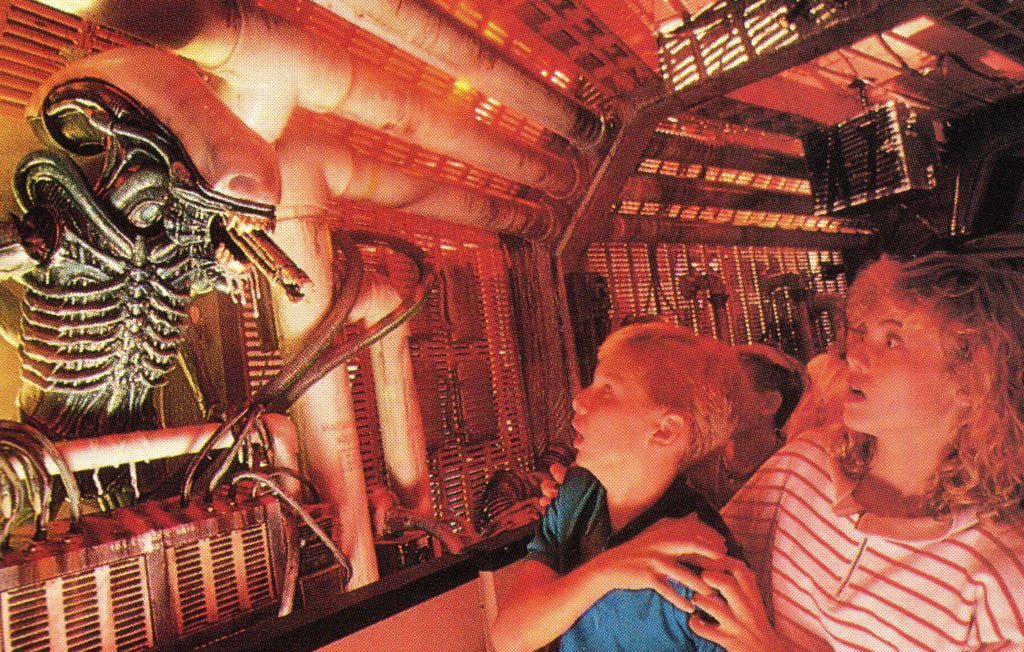
We’re with Sigourney Weaver’s Ripley aboard the space ship Nostromo. Something has gone wrong… Somewhere in the ship, a terrifying creature awaits… We’ve been transported into Alien. As in the 1979 blockbuster horror sci-fi classic, the unknown is our enemy…
The distant voice of the ship’s computer control counts down to self-destruction while the endless, steaming, industrial halls of the ship conceal the horrific creature… Fog bellowing, lights flashing, sirens wailing, the Xenomorph that terrorized a generation claws from the ceiling above the car, its striking mouths gnashing from overhead. Then, we hear it scurry back through the wall, erupting to our right with a roar and a hiss.
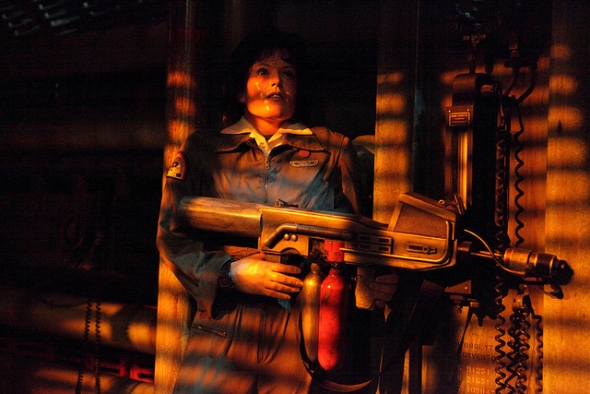
Our last view is that of Ripley – flamethrower in hand – ready for her final confrontation with the creature… but observant guests will note the thick, slimy mucas dripping ominously behind her…
(Interestingly, Alien represents one of the very few films on the ride to be owned by someone other than Disney or MGM. In fact, Disney acquired the theme park rights to Alien from 20th Century Fox in anticipation of building another Lost Legend: The ExtraTERRORestrial Alien Encounter. When the Xenomorph was determined to be too scary for the Magic Kingdom attraction, a new, original creature was devised instead.)
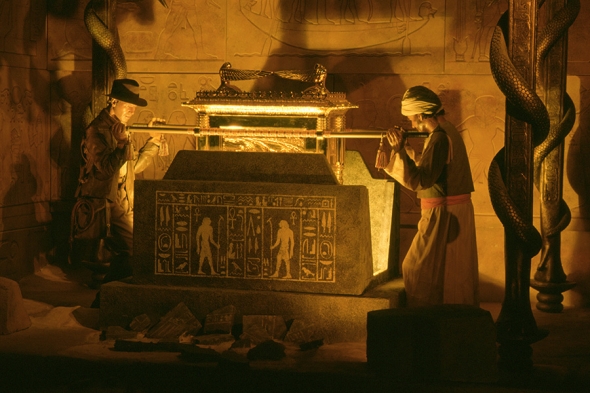
As the steaming, gritty, industrial wreckage of the beseiged Nostromo fades away, the unforgettable brass of John Williams’ “Raiders March” kicks in. The tram glides effortlessly through a pit filled with hissing, striking snakes, passing by Indiana Jones – famed hero of Raiders of the Lost Ark (the first film in the still-growing Indiana Jones franchise) – as he unearths the glowing, golden Ark of the Covenant.
The tram arrives in a never-before-disturbed ancient burial chamber where a towering, onyx statue of Anubus reigns. And there, embedded in its chest, is a radiating, priceless red gem. Our hijacker, Mugsy, notices the gem and throws on the brakes. He tip-toes off of the tram and begins to ascend a staircare onto Anubis’ lap. Our narrator warns, “The jewel is guarded by a curse… and those who dare defy that curse may pay with their lives.”
Reaching the gem, Mugsy is surprised by a cloaked figure standing on the altar, his back to us. “Halt, unbeliever. Disturb the treasure of the gods and you shall pay with your life.” It’s no skin off Mugsy’s back. He reaches up to the glowing gem and, upon making contact, a great hiss of steam is released from the ground around him. The white fog envelopes the scene and as the smoke clears, we see Mugsy (or what remains of him) reduced to bones. The cloaked figure? Our tour guide! She’s back! She fans the smoke away with her cloak, chipper as ever.
As the audience applauds, she returns to the helm of the tram without much ado. With a smile and a wink, she offers, “Just goes to show you that anything can happen in the movies! Now, on the with the show!”
Finale
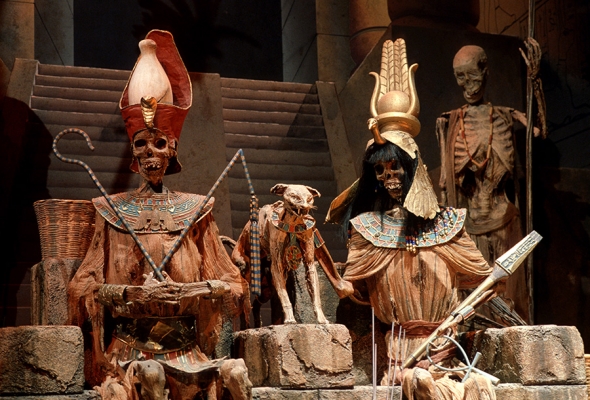
Next, we’re whisked through another kind of ancient Egyptian tomb… the kind seen in classic horror movies like those from the 1930s (eh hem, like Universal’s). As shambling, glowing, mummified corpses awaken, we glide out of the tomb at last and into the deep jungle.
It’s the set of 1932’s Tarzan the Ape Man, the first of a series of Tarzan films throughout the early-mid 1900s. Here, audio-animatronic figures of Tarzan swinging on a vine, Jane sitting on top of an elephant, and Cheeta the chimpanzee can be seen amongst the foliage.
Then, it’s on to the iconic finale of Casablanca, where animatronic figures of classic Hollywood royalty – Humphrey Bogart and Ingrid Bergman – stand in front of a waiting airplane.

While classic Disney lore would have you believe that the Lockheed Model 12 Electra Junior they stand before is the actual full-sized plane used in filming, no full-sized plane was even used in Casablanca’s production. (But the plane here is special. While its front end stands here, its rear end was aged and rusted and placed in Magic Kingdom’s Jungle Cruise as a piece of jungle wreckage.)
Next, we glide into our first taste of the finale… In a darkened room, projections bring the swirling stars, smashing waves, and whirling magic of The Sorcerer’s Apprentice (from 1940’s Fantasia) to life to the tune of Paul Dukas’ eponymous orchestral score. That frenzied magical chaos blends into a whirlwind… no, a tornado! And then, we emerge from the darkness and into the ride’s finale…
And what a journey it’s been. For nearly twenty minutes, we’ve been more than spectactors… we’ve been inside the movies. The thrills! The chills! The romance! From the musicals of yesteryear to today’s adventures, we’ve jumped between decades and styles, celebrated the grandeur of old Hollywood, and – maybe, just maybe – learned a thing or two along the way.
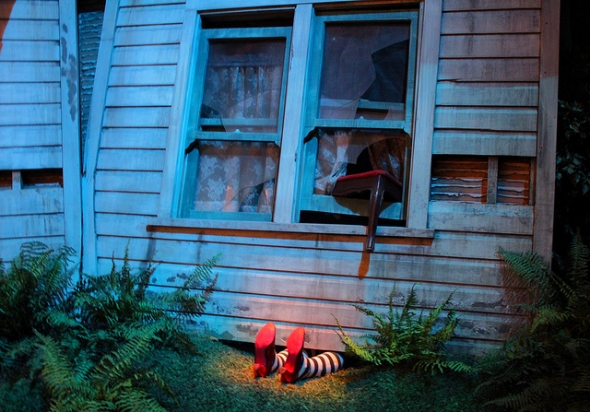
But of course, there’s only one fitting end to a cinematic journey: Oz.
Emerging from the swirling winds in the darkness, we’re greeted by the crashed home of Dorothy Gale (and the legs of her unfortunate victim, the Witch of the East) landed amongst the Technicolor wonder of Munchkinland. As windows open, the Munchkins emerge… “Ding, dong, the Witch is dead! Which old witch? The Wicked Witch!” they sing.
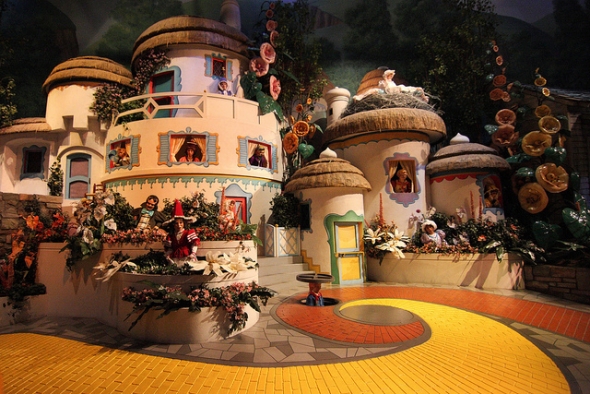
But their celebration is cut short…
In a burst of flaming fog, the Munchkins scream and retreat back into their homes… when the flames subside, we see that the green-skinned, hook-nosed Witch of the West has arrived, brought to life via an Audio-Animatronics figure so lifelike, you might swear the role was taken on by a live actress. Indeed, this howling mad Witch made our must-read countdown of the Best Animatronics on Earth.
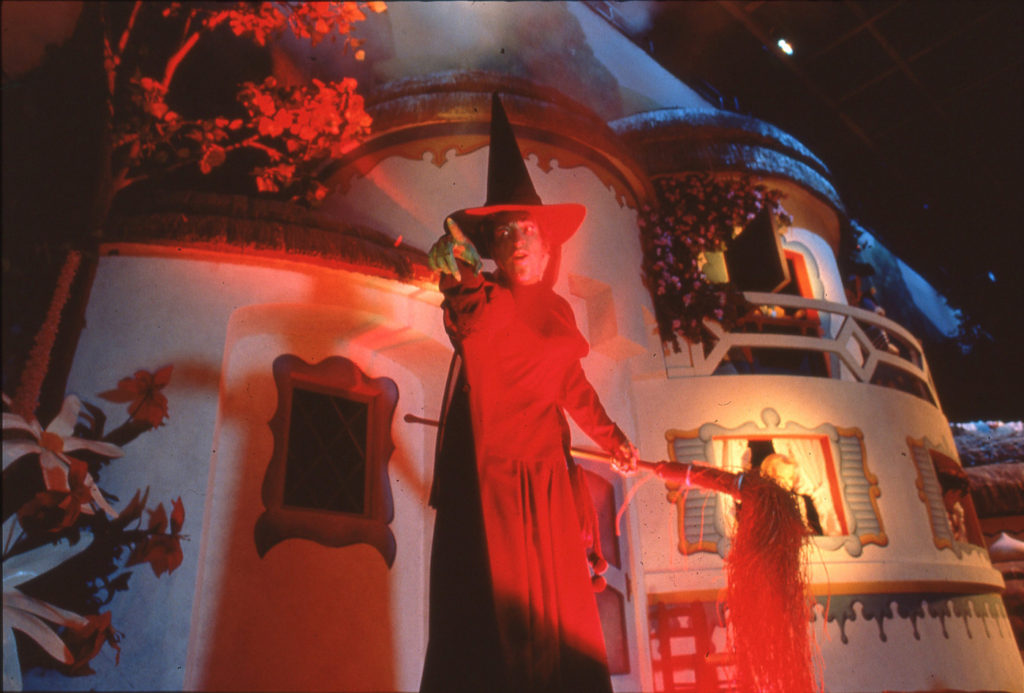
“Who killed my sister? Who killed the Witch of the East? Was it you?” She points to our guide threateningly.
“Well, I, uh… I… It was an accident! We didn’t mean to kill anybody!”
“Well, my pretty, I can cause accidents, too!”
“Oh rubbish,” our guide chuckles. “You have no power here! Now be gone, before someone drops a house on you, too!”
Repulsed, the Witch recoils. “Very well… I’ll bide by time… But just try to stay out of my way. Just try! I’ll get you, my pretty… and your little dog too!” Cackling, the Witch is encased again in thick, flaming fog and disppears in an instant, her sinister laugh echoing behind.
The Witch gone, it’s up to us to decide which way to go. Luckily, the Munchkins are here to help us out. “Follow the yellow brick road! Follow the yellow brick road! Follow, follow, follow, follow, follow the yellow brick road! We’re off to see the Wizard, the wonderful Wizard of Oz! He really is a whiz of a Wiz if ever a whiz there was!”
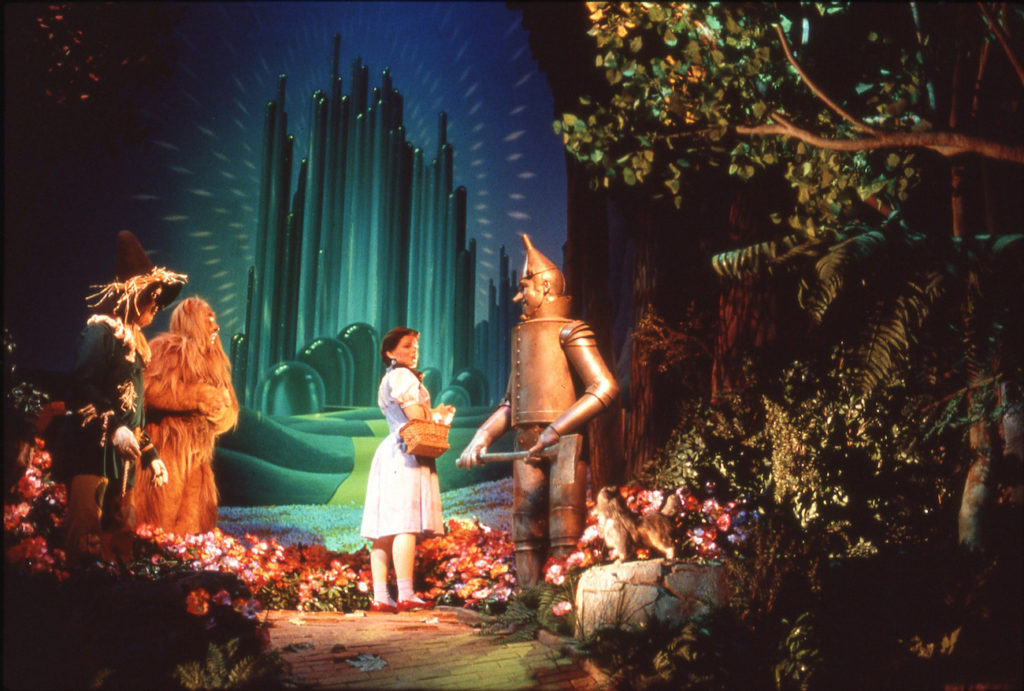
Emerging from the darkness, Dorothy, Toto, the Scarecrow, the Tinman, and the Cowardly Lion gaze upon the distant, glittering beauty of the Emerald City… a journey nearly complete.
And so it is for us, too.
Finally, both vehicles pull into a darkened theater, leaving their “single file” formation to park next to each other before a wraparound movie screen. Suddenly, the silver screen is alight with a cinematic montage of every other classic we missed (with literally hundreds of films represented). The idea? The movies are literally magic. For a century, cinema has been changing, and along the way, it changed us.
Content that we get the picture, the trams exit the theater one-by-one to return to their single file formation, arriving yet again back at the studio soundstage to disembark.
As always, we absolutely have to end our in-depth Lost Legends entry with a full ride-through video. Since we want to bring you the best video we can find to capture the sights, sounds, and feel of the Great Movie Ride, we’ve chosen the one below even though it includes changes brought to the ride’s narration and presentation in a 2015 renovation. (We’ll explain those changes in a bit):
Thesis
While the Disney-MGM Studios was a sometimes-clumsy balance of “behind-the-scenes” modern moviemaking and an elegant love letter to “a Hollywood that never was and always will be,” The Great Movie Ride struck that balance perfectly. While stepping “into” the movies, we also learned their connections; their stars; their stories. Somehow while inside our favorite films, we also zoomed out to see the big picture…
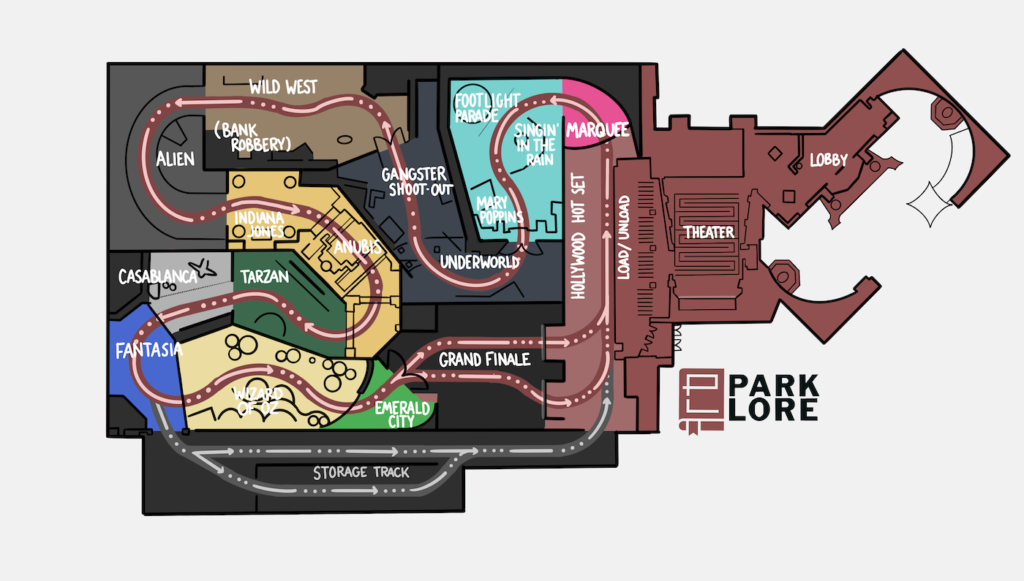
If nothing else, the Great Movie Ride succeeded at least in conveying the grand scope and scale of cinema, its storied roots, and the electric optimism and wonder of Hollywood’s Golden Age… the promise of stardom, the moving music, the inconcievable magic of the silver screen… If the Great Movie Ride helped at all to inspire a new generation to rent a VHS, DVD, or later Blu-Ray of even one of the classic works represented within, than it was well-worth its weight in gold.
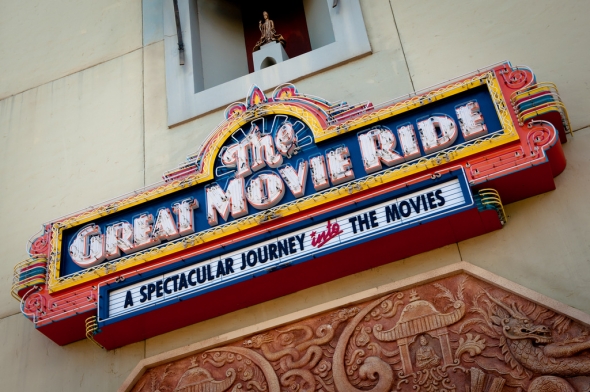
A stunning, epic, Epcot-sized dark ride through some of the greatest scenes in film history, the Great Movie Ride was a triumph and a fan favorite. And naturally, that meant it would be a candidate for duplication at other Disney Parks across the globe. You may not believe the places it almost ended up… On the next page, we’ll dissect the could’ve-been-clones of this animatronic-packed E-Ticket… then, we’ll finish up this entry by looking at what exactly happened to The Great Movie Ride, and how its closure signals the final curtain call for the “studio” theme park concept. Read on…


